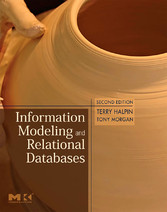Search and Find
Service
Front Cover
1
Information Modeling and Relational Databases
4
Copyright Page
5
Contents
8
Foreword by John Zachman
14
Foreword by Sjir Nijssen
18
Foreword by Gordon Everest
20
Preface
22
Chapter 1 Introduction
28
1.1 Information Modeling
29
1.2 Modeling Approaches
33
1.3 Some Historical Background
46
1.4 The Relevant Skills
50
1.5 Summary
51
Chapter 2 Information Levels and Frameworks
54
2.1 Four Information Levels
55
2.2 The Conceptual Level
59
2.3 Database Design Example
70
2.4 Development Frameworks
75
2.5 Summary
82
Chapter 3 Conceptual Modeling: First Steps
86
3.1 Conceptual Modeling Language Criteria
87
3.2 Conceptual Schema Design Procedure
89
3.3 CSDP Step 1: From Examples to Elementary Facts
90
3.4 CSDP Step 2: Draw Fact Types and Populate
108
3.5 CSDP Step 3: Trim Schema; Note Basic Derivations
122
3.6 Summary
131
Chapter 4 Uniqueness Constraints
136
4.1 Introduction to CSDP Step 4
137
4.2 Uniqueness Constraints on Unaries and Binaries
138
4.3 Uniqueness Constraints on Longer Fact Types
149
4.4 External Uniqueness Constraints
155
4.5 Key Length Check
164
4.6 Projections and Joins
177
4.7 Summary
182
Chapter 5 Mandatory Roles
186
5.1 Introduction to CSDP Step 5
187
5.2 Mandatory and Optional Roles
189
5.3 Reference Schemes
201
5.4 Case Study: A Compact Disc Retailer
220
5.5 Logical Derivation Check
227
5.6 Summary
234
Chapter 6 Value, Set-Comparison, and Subtype Constraints
238
6.1 Introduction to CSDP Step 6
239
6.2 Basic Set Theory
239
6.3 Value Constraints and Independent Types
243
6.4 Subset, Equality, and Exclusion Constraints
251
6.5 Subtyping
265
6.6 Generalization of Object Types
287
6.7 Summary
295
Chapter 7 Other Constraints and Final Checks
298
7.1 Introduction to CSDP Step 7
299
7.2 Occurrence Frequencies
299
7.3 Ring Constraints
304
7.4 Other Constraints and Rules
316
7.5 Final Checks
322
7.6 Summary
330
Chapter 8 Entity Relationship Modeling
332
8.1 Overview of ER
333
8.2 Barker notation
335
8.3 Information Engineering notation
345
8.4 IDEF1X
349
8.5 Mapping from ORM to ER
361
8.6 Summary
369
Chapter 9 Data Modeling in UML
372
9.1 Introduction
373
9.2 Object-Orientation
375
9.3 Attributes
378
9.4 Associations
384
9.5 Set-Comparison Constraints
391
9.6 Subtyping
399
9.7 Other Constraints and Derivation Rules
403
9.8 Mapping from ORM to UML
415
9.9 Summary
422
Chapter 10 Advanced Modeling Issues
426
10.1 Join Constraints
427
10.2 Deontic Rules
435
10.3 Temporality
438
10.4 Collection Types
459
10.5 Nominalization and Objectification
466
10.6 Open/Closed World Semantics
477
10.7 Higher-Order Types
483
10.8 Summary
496
Chapter 11 Relational Mapping
500
11.1 Implementing a Conceptual Schema
501
11.2 Relational Schemas
502
11.3 Relational Mapping Procedure
510
11.4 Advanced Mapping Aspects
537
11.5 Summary
552
Chapter 12 Data Manipulation with Relational Languages
554
12.1 Relational Algebra
555
12.2 Relational Database Systems
581
12.3 SQL: Historical and Structural Overview
583
12.4 SQL: Identifiers and Data Types
585
12.5 SQL: Choosing Columns, Rows, and Order
589
12.6 SQL: Joins
597
12.7 SQL: In, Between, Like, and Null Operators
609
12.8 SQL: Union and Simple Subqueries
618
12.9 SQL: Scalar Operators and Bag Functions
629
12.10 SQL: Grouping
638
12.11 SQL: Correlated and Existential Subqueries
646
12.12 SQL: Recursive Queries
653
12.13 SQL: Updating Table Populations
656
12.14 Summary
658
Chapter 13 Using Other Database Objects
664
13.1 SQL: The Bigger Picture
665
13.2 SQL: Defining Tables
665
13.3 SQL: Views
673
13.4 SQL: Triggers
679
13.5 SQL: Routines
682
13.6 SQL: More Database Objects
685
13.7 Transactions and Concurrency
689
13.8 Security and Meta-Data
691
13.9 Exploiting XML
693
13.10 Summary
711
Chapter 14 Schema Transformations
714
14.1 Schema Equivalence and Optimization
715
14.2 Predicate Specialization and Generalization
719
14.3 Nesting, Coreferencing, and Flattening
729
14.4 Other Transformations
745
14.5 Conceptual Schema Optimization
749
14.6 Normalization
761
14.7 Denormalization and Low Level Optimization
780
14.8 Reengineering
786
14.9 Data Migration and Query Transformation
793
14.10 Summary
796
Chapter 15 Process and State Modeling
800
15.1 Introduction/Modeling Dynamic Behavior
801
15.2 Processes and Workflow
804
15.3 State Models
812
15.4 Foundations for Process Theory
822
15.5 Modeling Information Dynamics in UML
827
15.6 Business Process Standards Initiatives
839
15.7 Standard Process Patterns
846
15.8 Summary
859
Chapter 16 Other Modeling Aspects and Trends
862
16.1 Introduction
863
16.2 Data Warehousing and OLAP
863
16.3 Conceptual Query Languages
870
16.4 Schema Abstraction Mechanisms
879
16.5 Further Design Aspects
884
16.6 Ontologies and the Semantic Web
891
16.7 Postrelational Databases
898
16.8 Metamodeling
908
16.9 Summary
915
ORM glossary
920
A
920
B
920
C
920
D
921
E
921
F
921
G
921
I
921
M
921
N
921
O
922
P
922
R
922
S
922
T
922
U
922
V
922
ER glossary
930
UML glossary
934
Useful Web Sites
938
Bibliography
940
Index
952
Symbols and Numbers
952
A
952
B
953
C
953
D
956
E
957
F
958
G
958
H
959
I
959
J
960
K
960
L
960
M
960
N
961
O
961
P
963
Q
964
R
964
S
965
T
967
U
968
V
969
W
969
X
969
Y
969
Z
969
About the Authors
970
All prices incl. VAT














